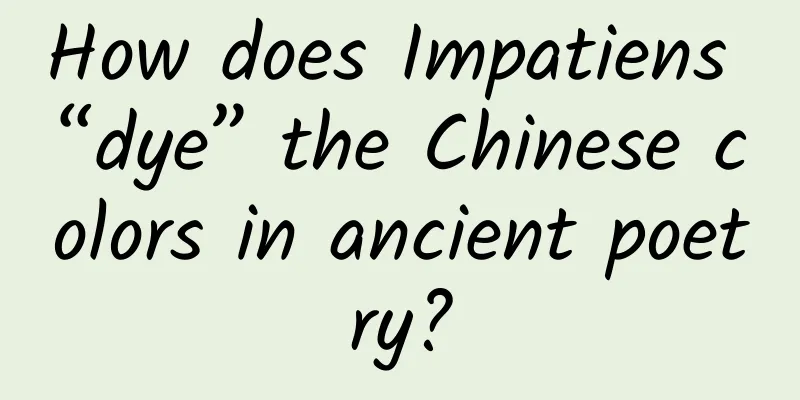How does Impatiens “dye” the Chinese colors in ancient poetry?

|
Produced by: Science Popularization China Author: Zhang Xiaoxia (Institute of Botany, Chinese Academy of Sciences) Reviewer: Yu Shengxiang (Institute of Botany, Chinese Academy of Sciences) Producer: China Science Expo "To dye my slender nails red, I pounded Impatiens in a golden basin at night." Since ancient times, nature has endowed people with a natural beauty - Impatiens. Take a petal and attach it to your nails. Wait for a while and the bright color will stay on the nails. How long has the history of Impatiens been used for nail dyeing? Why does it have such a fairy-like name? Let's walk into the colorful world of Impatiens... Dyeing the girl's slender fingers, pink, white, dark green and more beautiful Impatiens, also known as henna and golden phoenix, was used by ancient people to dye their nails with the juice of its petals, and its popularity far exceeded the enthusiasm of people today for nail art. According to legend, Yang Guifei of the Tang Dynasty was born with red nails, which were very eye-catching. People in the palace followed suit, setting off a trend of pursuing colorful nail art. Figure 1 Impatiens balsamina (Photo credit: Photo by Zhang Xiaoxia) Tang Dynasty poet Li He recorded the daily life scene of palace maids preparing Impatiens balsamina juice for nail dyeing in his "Gong Wa Ge". "The candlelight hangs high and illuminates the sky, and the flower room pounding red geckos at night." Red geckos are made from the juice of crushed Impatiens balsamina flowers. Nails dyed with Impatiens balsamina can be colored for several months without fading, and have always been loved by people. Therefore, there are many records about its cultivation and nail dyeing in all dynasties. For example, Zhou Mi's "Guixin Miscellaneous Notes" in the Song Dynasty recorded in detail the method of Jinfeng nail dyeing: "If the Impatiens balsamina is red, crush its leaves and add a little alum. Wash the nails first, then put it on the nails and wrap it with a piece of silk overnight. The color is light at first, but after dyeing three or five times, the color is like rouge and cannot be washed off. It can last for ten days until the nails fade, and then gradually remove it." It can be said that the Song people's alum mordant dyeing technique is recorded in great detail, and this technique has been used to this day. In addition, it also records that everyone in the Song Dynasty loved beauty, and it was common for girls in the boudoir to women in their seventies and eighties to dye their nails. There are also records that Arab women who settled in the Song Dynasty at that time would dye their cats and dogs with Impatiens while dyeing their nails, enjoying dressing up their pets. Figure 2 shows the custom of dyeing nails during the Dragon Boat Festival recorded in ancient Chinese folk paintings Pick Impatiens in front of the steps on the Dragon Boat Festival, add alum in a small bowl and grind it carefully. The daughter's slender fingers are dyed red, and the pink, white and green make them more beautiful. The potted plant in the lower left corner of the painting is Impatiens (Image source: Reference [1]) From the Tang and Song Dynasties to the Yuan, Ming and Qing Dynasties, people's love for Impatiens has continued to grow. During the Yuan Dynasty, there was a poem called "Imperium balsamina" which goes: "The fairy flowers are pounded in a golden plate with dew, making the slender jade-like nails look flawless. A little bit of worry like a parrot's beak, and very much like a peony bud just grown in spring." The poem describes the slender red nails dyed with Impatiens balsamina, which look a little like a parrot's beak, and very much like a peony bud just grown in spring. By the Ming Dynasty, there was a poem called "Whose tune is this flute playing? The Milky Way flows westward, and the moon is half-set. To dye my slender nails red, I pound impatiens in a golden basin at night." In the Ming Dynasty poetry, which was relatively lacking in romantic sentiment, under the setting moonlight on the river bank, accompanied by the melodious and quiet flute music, dyeing slender nails red with impatiens was a romantic and elegant entertainment activity that perfectly matched the moonlight and the music. In the Qing Dynasty, dyeing nails with Impatiens balsamina became a daily entertainment activity for girls in the boudoir. In Cao Xueqin's Dream of the Red Chamber, there are many descriptions of girls in the Grand View Garden dyeing their nails with Impatiens balsamina. For example, Qingwen, Jia Baoyu's maid, had three-inch long nails dyed red with Impatiens balsamina (Figure 3). Figure 3 In the TV series Dream of Red Mansions (1987 edition), the color of Qingwen's fingernails is very similar to the color of Impatiens. (Photo source: Stills from "A Dream of Red Mansions" (1987 edition)) In fact, it is not only the ancients, but most girls today have also experienced the fun of dyeing their nails with henna when they were young. Because Impatiens is one of the most common garden flowers , the raw materials are easy to obtain, and it usually blooms in summer. The colors are different, ranging from white, pink, peach, red, purple, yellow, etc., and the flowering period is long. It is not difficult to plant and can be planted in front of or behind the house. When I was a child, I also played the activity of dyeing nails with Impatiens with my sisters. The dyed nails are indeed not as beautiful as nail polish, but the fun of a group of playmates dyeing each other's nails is also one of the best memories of childhood. The phoenix flies like a fairy, and its fragrance is hard to distinguish In fact, when I first started studying plant taxonomy, I had a very puzzling question in my mind. How could the common Impatiens, which is so down-to-earth, have such a fairy-like name? It was not until I was studying for my master's degree and followed my supervisor to collect Impatiens specimens in the field that I gradually understood where the "fairy" temperament of this group came from. Although Impatiens is very easy to grow and has a variety of flower colors, if you look closely, there are not many species of the Balsaminaceae family that can be seen in daily life. One is Impatiens balsamina (Impatiens balsamina) which is native to India and has been cultivated for thousands of years (Figures 1 and 4). The other two are Impatiens hawkeri (Impatiens hawkeri) (Figure 5a) which was introduced in recent years and Impatiens walleriana (Impatiens walleriana) which is native to Africa (Figure 5b). Apart from these three species, other species are not easy to find. These common Impatiens species are not only few in number, but also have undergone many artificial selections in terms of flower color, leaf color, double petals, etc. In addition, they are often planted in cities and rural areas, and have indeed lost their original "fairy spirit", leaving only the worldly air. Figure 4 Impatiens balsamina stamp from the Republic of Indonesia (Photo credit: Photo by Zhang Xiaoxia) Figure 5 New Guinea Impatiens (Impatiens hawkeri) and Sudan Impatiens (Impatiens walleriana) (Photo credit: Photo by Zhang Xiaoxia) To truly appreciate the "fairy" nature of Impatiens, you need to go into the wild, to the vast mountainous areas of southwestern China, which is the center of diversity distribution of Impatiens plants native to China. In the mountains, beside streams, in caves and valleys, you can see the plump and watery stems with many branches, on which many bird-like flowers are dancing in the wind. These are the relatives of Impatiens far away in the mountains - the Impatiens family. The name "Impatiens" comes mainly from the peculiar shape of its corolla . The Compendium of Materia Medica records that "its flower head, wings, tail and feet are all upturned like a phoenix, hence the name". The cultivation of Impatiens balsamina became popular in the Tang Dynasty, and from the research of cultural relics, the phoenix pattern had already evolved into a shape in the Tang Dynasty, with a beautiful upturned tail and open wings that looked very prancing (Figure 6a). The corolla of Impatiens is very similar to a phoenix pattern (Figure 6b). The pedicel or axis of the inflorescence is relatively slender, and the flowers sway gracefully on the branches like a flying phoenix, hence the name that carries a "fairy-like" feeling and beautiful meaning. Figure 6 Phoenix patterns from the Tang Dynasty and corollas of plants of the Impatiens family that resemble phoenix patterns (a) Phoenix pattern from the Tang Dynasty; (b) Side view of Impatiens macrovexilla (Image source: Figure (a) Reference [2]; Figure (b) Reference [3]) However, botanists' understanding of the flowers of Impatiens is far more than just "phoenix-like". The morphological characteristics of the flower are the key traits for the classification of Impatiens . To understand Impatiens, one needs to first understand the various parts of the flower. A big part of the reason why Impatiens is so beautiful is that its calyx is petalized , and both the calyx and the petals have high ornamental value. In fact, not all Impatiens are as light as a phoenix. Some are as plump as a goldfish, such as Impatiens corchorifolia (Figure 7). We can see that a flower has a larger standard petal and two larger and symmetrical wing petals, which are actually formed by the union of two petals. In addition, there are four smaller sepals and a very specialized lip, which swells into a sac-like or funnel-like shape, and its tail often shrinks into a tubular spur, called a honey spur (Figure 7c). Figure 7 Anatomy of the flower and its parts of Impatiens balsamina (Image source: Reference [4]) This sac-like pouch is the most important "sweet" weapon of Impatiens. The spurs at the tail can produce and store nectar, attracting insects to come for pollination. The combined wing petals, one on the left and one on the right, just set up a "landing pad" for pollinating insects, waiting for insects to come and "land" to collect nectar and pollinate (Figure 7). Figure 8 Impatiens trichosepala’s “helipad” (Image source: Reference [3]) The shape, length and curvature of the lip spur can affect the efficiency of insect pollination. Scientists observed a group of Impatiens capensis plants and found that bees stayed longer on flowers with longer and more curved spurs, and left less nectar in the more curved spurs after flying away. The longer insects stay on flowers, the higher the success rate of plant pollination, thus increasing the probability of seed production. For example, the flower of the spotted orange impatiens with a longer spur and a greater curvature of 180° (Figure 9b) has a longer spur than the flower in Figure 9a, and a greater curvature than the flower in Figure 9c. Overall, the flower in Figure 9b has a slight advantage and is the most popular flower for bees. In the long evolutionary history, the spurs of the Impatiens family have also evolved a variety of shapes (Figure 10) to adapt to the mouthparts of different insects that pollinate them. Fig. 9 Variation of the length and curvature of the midspur in natural populations of Impatiens capensis The curvature of the yoke is approximately 360°, 180° and 90° respectively. (Image sources: (a) Chris Evans, University of Illinois, Bugwood.org; (b) George Rembert, CalPhotos Photo Database; (c) Online Virtual Flora of Wisconsin) Fig. 10 Diversity of the lip and spur of Impatiens (a) Impatiens serrata; (b) Impatiens sodenii; (c) Impatiens tubulosa; (d) Impatiens bodinieri; f Impatiens soulieana (Image source: Reference [4]) In short, the flowers of Impatiens plants evolved such exquisite and peculiar flower shapes, originally for their own very important way of survival and reproduction, and their high ornamental value may be just an unintentional act in the evolutionary process, not for our pleasure. Although the three common cultivated Impatiens plants are not native to my country, my country has a very rich variety of wild Impatiens plants. Impatiens is a small family among angiosperms because it has only two genera, including Impatiens, which is the focus of this article, and Hydrocera, which has only one species, Hydrocera triflora (Figure 11). Figure 11 Hydrocera triflora (Photo credit: Photo by Zhang Caifei) The genus Impatiens is a large genus with about 1,000 species. Plants of the two genera of Impatiens are naturally distributed in China, with a total of about 270 species, accounting for about one-third of the world's Impatiens plants. It can be said that the wild resources are very rich. Due to my professional studies, I have also had the opportunity to appreciate the various graceful and beautiful figures of Impatiens plants in China (Figure 12). It can be said that a group of "immortals" have gathered together to share the beauty. The colorful wild Impatiens resources provide rich genetic germplasm resources for the selection and breeding of Impatiens flower varieties with higher ornamental value. Figure 12 Various poses of Chinese Impatiens plants (Image source: Reference [3]) Conclusion Although the plants of the genus Impatiens have different postures, it has to be mentioned that the taxonomic research of this group is relatively difficult. For beginners, one has to sigh - "It is difficult to distinguish the fragrant flowers from the fragrant ones." Because the plant contains a lot of water and is fleshy, it is difficult to keep the wax leaf specimens in the wild state, which undoubtedly increases the difficulty of research. Therefore, we should observe its wild state in nature more often to obtain more valuable taxonomic research data. Although it is difficult, we can also appreciate this beautiful gift brought to us by nature. References: [1] Xiang Baisong. (2019) The strange customs and practices of the Dragon Boat Festival in history[N]. China Art Newspaper. 2019-06-07, p. 08. [2] Li Yi. (2006). Exploring the evolution of phoenix patterns from bronze decorations of the Shang Dynasty [J]. Art Panorama: 128-129. [3] Yu Shengxiang. (2012). Impatiens balsamina. Peking University Press[M]. [4] Yu, SX, Janssens, SB, Zhu, XY, Lidén, M., Gao, TG, and Wang, W. (2016). Phylogeny of Impatiens (Balsaminaceae): integrating molecular and morphological evidence into a new classification [J]. Cladistics 32: 179-197. [5] Young, HJ (2008). Selection on spur shape in Impatiens capensis [J]. Oecologia 156: 535-543. (Note: Latin text should be italicized.) |
Recommend
Which housing loan interest rate is better? The difference between fixed and floating interest rates in 2020
When converting the pricing of existing mortgage ...
Why did Huawei and Xiaomi choose e-commerce to enter the Indian market?
In 2007, two young men, Sachin Bansal and Binny B...
What is the timetable for the 2022 Beijing College Entrance Examination? What month and date is the exam?
The 2022 Beijing College Entrance Examination wil...
Cats and dogs seem very smart, so why don’t they have consciousness?
In the posts about consciousness that I have publ...
How to play in Douyin store group? A complete guide to Doudian operation
With the popularity of Douyin live streaming and ...
What is invisible secondary pollution?
How do you define whether your home is clean if y...
Aston Martin: Sales in China to plummet 49% in 2024
Recently, it was reported that, against the backdr...
New Android virus: Can root any phone and cannot be deleted
[[155228]] Beijing time, November 6th morning new...
Are the groundhogs in "Nezha 2" too cute? Keep away! They can also spread the plague
Recently, the marmot family in the movie "Ne...
Horrible! A man sleepwalked and jumped out of the window on the 7th floor! The "culprit" of sleepwalking may be...
Expert of this article: Xue Shimin, deputy chief ...
You never expected that the "good habits" you have been sticking to may drag down your body
Reviewer of this article: Chen Haixu, Deputy Dire...
Ten tips on advertising
Many people understand advertising as "burni...
Three tricks for short video marketing promotion: KOL + topicality + in-depth interaction
Introduction: In today's mobile era, short vi...
The menstrual beauty technique that both Christy Chung and Yip Yi-qian are learning can make you look ten years younger!
It's not easy to be a woman To accompany chil...
Huanwang Technology: Cross-border, smart large-screen investment enters the third stage
Since 2020, the smart large-screen industry has a...









